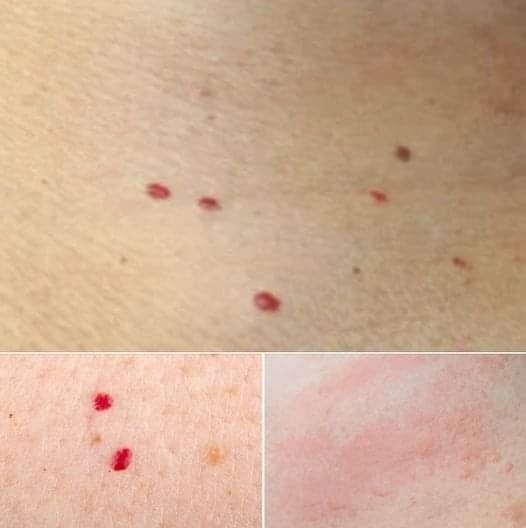- Petechiae and Purpura
What they look like: Tiny, pinpoint red or purple spots that don’t fade when pressed.
Common causes: These spots result from tiny blood vessels (capillaries) leaking beneath the skin. They may appear after intense coughing, vomiting, certain medications, or minor trauma.
When to seek help: If the spots appear suddenly, spread quickly, or are accompanied by fever, bruising, or fatigue, they could signal a medical issue. It’s best to get evaluated by a healthcare provider. - Cherry Angiomas
What they look like: Bright red, round bumps that may be slightly raised.
Why they occur: These are common and benign clusters of blood vessels that often develop with age.
Treatment: No medical treatment is necessary unless they bleed often or become bothersome. Dermatologists can remove them if needed. - Heat Rash (Miliaria)
What it looks like: Small, itchy red bumps, often found in areas prone to sweating.
Why it happens: Caused by blocked sweat ducts, especially in hot and humid conditions.
Care tips: Keep skin cool, wear breathable clothing, and avoid overheating. It usually resolves on its own. - Allergic Reactions
What it looks like: Red, itchy patches or raised hives that appear suddenly.
Common triggers: Foods, medications, insect bites, or environmental allergens.
What to do: Avoid the known trigger and consider antihistamines. Seek emergency care if symptoms include swelling of the face or difficulty breathing. - Folliculitis
What it looks like: Red, pimple-like bumps surrounding hair follicles.
Causes: Often related to bacterial or fungal infection, shaving, friction, or irritation.
Treatment: Mild cases may clear with hygiene and warm compresses. More persistent infections may require prescription creams or antibiotics. - Cellulitis
What it looks like: Red, swollen, warm, and often painful skin that can spread.
Why it’s serious: This is a bacterial infection that affects deeper layers of skin.
Urgency: Requires prompt medical attention and treatment with antibiotics. - Impetigo
What it looks like: Red sores that ooze and form a honey-colored crust.
Who it affects: Common among children and highly contagious.
Treatment: Typically resolves with antibiotic creams or medications; good hygiene helps prevent its spread. - Vasculitis
What it looks like: Red or purple spots that can resemble bruises or blotchy patterns.
Underlying causes: Inflammation of blood vessels, sometimes linked to autoimmune conditions or infections.
Next steps: Medical evaluation is important. Treatment may involve managing inflammation with medication. - Hemangiomas
What they look like: Bright red or purplish raised spots, often present from infancy.
Why they happen: These are benign blood vessel growths.
Treatment: Many fade over time without treatment, but some may require monitoring or removal if they grow rapidly or interfere with vision, breathing, or movement.
When to See a Doctor
While many red dots are harmless, it’s a good idea to consult a medical professional if:
The spots appear suddenly or multiply quickly.
You also experience fever, fatigue, or unusual bruising.
The skin feels painful, hot, or tender.
You have existing conditions affecting your immune system or blood clotting.
The red marks don’t improve or continue to return.
Final Thoughts
Your skin can be a helpful indicator of your overall health. While red spots are often minor, paying attention to their timing, appearance, and any accompanying symptoms can help you make informed decisions. When in doubt, don’t hesitate to reach out to a healthcare provider—they can help you rule out serious causes and offer peace of mind.

